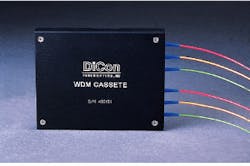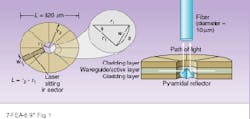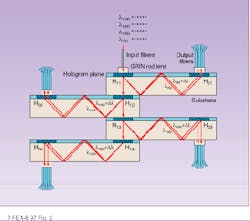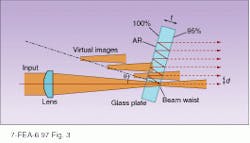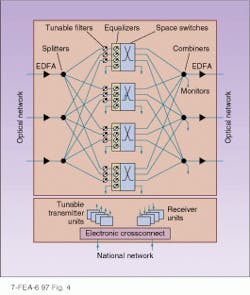Today, only a fraction of the enormous potential capacity of optical fibers is being utilized. In just the slice of the spectrum from 1.55 to 1.56 µm, there is a theoretical information capacity of 2 Tbit/s, but the best commercialized fiber communication systems carry only about 10 Gbit/s. To expand capacity to meet the growing demand for information transfer, the huge bandwidths of optical fibers have to be used more efficiently. By far, the most advanced way of doing this is wavelength division multiplexing (WDM)—the sending of multiple signals with different wavelengths on the same fiber.
Wavelength division multiplexing is just beginning to come into commercial use, with one of the first WDM systems deployed in fall 1995 by Pirelli Cable Corp. (Lexington, SC). Its development is complex because the use of WDM means remaking every part of the system except the fiber itself—multiplexers, switches, networks, and demultiplexers all have to be designed and tailored to WDM requirements (see photo at top of this page). Currently, research and development are progressing in all these areas including systems integration. In the San Francisco Bay, CA, area, for example, a consortium of universities and telecommunications companies—the National Transparent Optical Network consortium—started in February 1996 to develop a regional prototype WDM network to test both components and system designs (see Laser Focus World, Sept. 1996, p. 129). As yet, such networks are limited to four wavelengths, but the ultimate goal is a system that uses hundreds of wavelengths, with system capacity of more than a terabit per second.
Merging the data streams
The first element in a WDM system is a multiplexer to get signals with different wavelengths, produced by separate lasers and modulators, onto a single fiber. Coupling the light from several sources is not a trivial problem, because, if this is done by bending fibers together in a coupling region, bending radii cannot be less than 4 mm to avoid excessive light losses. (When optical fiber bends, the critical angle can be exceeded for some light rays, which are partially transmitted rather than wholly reflected and lost to the fiber.)
One approach for compact couplers, developed by M. Scott McGovern and Allen Rothwarf of Drexel University (Philadelphia, PA), is to produce each wavelength in a wedge of a circular array (see Fig. 1). At the center of the array is a pyramidal reflector that redirects the light by 90 into the output fiber. An eight-laser array would be 0.8 mm across and have 96% of its area available for drive and control circuits for the lasers.Once the multiple-wavelength signal is in the fiber, the real challenges begin. Conventional fiber was optimized for signals on a single wavelength; with multiple wavelengths and channels generally closely spaced, fiber nonlinearities introduce crosstalk between channels, thus limiting the number of wavelengths carried. One significant nonlinearity is four-wave mixing (FWM), in which two signals at different frequencies interact through the nonlinear refractive index of the fiber to produce additional signals at the sum and difference between the frequencies. Nonlinearity increases as the frequencies are more closely spaced, with increasing power per channel and with decreasing dispersion of the medium.
Performance is decreased both by loss of power and, in cases of evenly spaced channels, by crosstalk, as the nonlinearly generated components can fall directly onto existing channels. Potentially, channels separated by 4 nm can be limited by FWM to link fiber lengths of less than 500 km.
One simple approach to lessen these nonlinearities is to use unequal channel spacing. This design avoids crosstalk but not power loss and makes inefficient use of the available bandwidth. A more-sophisticated approach is to use semiconductor laser amplifiers at the midpoint of a link to perform phase conjugation or spectral inversion of the signal. This automatically recovers the original signal at the endpoint, but introduces complexity into the network.
A third technique is to use higher-dispersion fiber, alternating these sections with sections of dispersion-compensating fiber, so that average dispersion is low, but each fiber section has high dispersion. Using this technique, researchers have demonstrated transmission of sixteen 10-Gbit/s channels over 1000-km links.
A second nonlinearity is stimulated Raman scattering (SRS), in which light stimulates molecular vibration, generating scattered light at a slightly longer wavelength than the original signal. Again crosstalk and loss of signal energy result. This effect is exacerbated with more closely spaced and more powerful channels. While currently there is no apparent way to counteract SRS, it is less constricting than FWM—eight wavelengths spaced 4 nm apart can still travel 1000 km without significant degradation by SRS. However, care has to be taken to limit channel power to the minimum needed for good signal-to-noise ratios.
It is possible that some of these nonlinear effects can be used to enhance WDM system efficiency, rather than degrade it. One such effect—cross-phase modulation—leads pulses on two different wavelengths, but close to each other in time, to attract each other, as each influences the refractive index of the medium. C. Yeh and L. Bergman at the Jet Propulsion Laboratory (Pasadena CA) have shown theoretically that by deliberately introducing a "shepherd pulse" on a third beam, pulses on two other wavelengths can be pulled into excellent alignment in time. This approach could be important in systems that require pulses that start together to arrive together, because, without shepherding, signals at different wavelengths pulses tend to have slightly different propagation speeds.
Amplification is also a major problem in the design of WDM systems. Because of the time delays inherent in electronic amplification of optical signals—where the optical signal is converted to an electronic one and then recreated as an optical signal—fiber networks are already moving rapidly toward the use of erbium-doped fiber amplifiers (EDFAs). In these amplifiers, the signal is simply optically amplified without being recreated, eliminating bottlenecks. [EDFAs will be the focus of the next Back to Basics article -Ed.]
But EDFAs do not amplify equally at all wavelengths, and repeated amplification by these devices would lead to unacceptably large differences in signal strength. A number of techniques for flattening amplifier response are currently being researched (see Laser Focus World, June 1996, p. 177). For example, Fabry-Perot gratings can couple some of the light from high-gain wavelengths into readily attenuating modes in the fiber cladding. Alternatively, tunable gain equalizers can be placed after a certain number of amplifiers, optical filters can be used, or fluoride-based amplifier fiber can be used, which gives a flatter response.
Taking the signal apart
Once the signal has been successfully transmitted, the different wavelengths must be separated or demultiplexed before they are converted to electronic signals at the receivers. Some of these demultiplexing techniques were discussed in earlier Back to Basics articles (see Laser Focus World, May 1997, p. 203).
As the number of wavelengths to be separated increases, sophisticated methods are needed to keep demultiplexer size and complexity manageable. One concept under development is the cascaded holographic grating proposed by researchers at the National Chiao Tung University in Taiwan. Input light passes through a holographic grating tuned to separate out a given band of wavelengths (see Fig. 2). The other wavelengths pass through to a second grating and so on. Each grating separates out a range of wavelengths so that a four-layer cascade can separate as many as 80 channels.Getting the address right
Another key area affected by WDM is network switching and overall system design. On the one hand, WDM complicates switching considerably, because in most systems a given message is wavelength-coded. But, on the other hand, the very great capacity of WDM will make possible new network designs that could potentially eliminate switching altogether for some applications.
A typical WDM node will contain a crossconnect switch consisting of demultiplexers, beamsplitters to send part of each beam to each space switch, tunable filters to allow or block a given message for a given switch, and space switches to direct the signal to the proper output node (see Fig. 4). Such units also must contain EDFAs to boost the signals back up to their original strength.Tunable filters are based on the same technology as modulators (see Laser Focus World, April 1997, p. 127). Two common types are acousto-optic filters, which use acoustic waves, and tunable Fabry-Perot filters, which use piezoelectric actuators. Both, however, have limitations in speed.
Another approach to faster filters are those based on the photorefractive effect, an optically induced change in the refractive index. When the crystals, for example, barium titanate or lithium niobate, are illuminated with an optical intensity pattern, electrons move to the dark regions, separating charge and creating very large electric fields (kilovolt per centimeter). These fields, in turn, change the refractive index through the electro-optic effect. If this intensity pattern is in the form of a spatial Bragg grating, produced by the interference of two laser beams, then a narrowband filter is produced. To change the frequency filtered for, the angle between the light beam is changed, thus changing the grating spacing.
Work on such optically tunable filters is being carried out at the University of Toronto (Canada), among other facilities. While crystals currently being studied are relatively slow, others, such as iron-doped indium phosphide, have faster response times—on the order of 100 µs. Still faster responses will be needed for commercial systems.
Because near-term networks will be limited to at most 10 wavelengths, messages traveling through the network will have to be able to hop from one wavelength to another. For this, wavelength converters or translators, which change the wavelength of a given signal, are essential. The leading candidate for such converters is a gain-saturated semiconductor-laser amplifier. The signal to be translated and a carrier at the new wavelength are both fed into the amplifier. Because the amplifier is near saturation, when a pulse is present on the moderated signal, the gain on the carrier is reduced. The carrier thus ends up with a phase-reversed modulation from the original signal (see Fig. 5). A filter then removes any residual power in the input signal.Although this is a bit complex, WDM can potentially reduce the total amount of switching needed. For example, in an electronic network a header that routes a packet of information is a binary word, and its length can`t be too long without interfering with carrying efficiency. However, in a 10-wavelength network, a similar header could have 10 bits in each of ten wavelengths, enough for 10 billion addresses (see Laser Focus World, March 1996, p. 35). Researchers at the University of California-Berkeley, Stanford University, and University of California-Santa Cruz have partially demonstrated such a system and believe that it could rapidly reduce the number of stages in a switching network.
Furthermore, a European Framework project called Mundi aims to develop a system that would eliminate switches altogether from telephone networks. Callers would be allocated an open frequency that everyone else would receive. A code would insure that only the intended receiver would respond to the signal, establishing a connection. Such applications are not near-term, as they require far more wavelengths than will soon be available. However, they may become quite feasible as future generations of WDM systems drive used capacity on fibers up to a theoretical maximum of hundreds of terabits per second.
FURTHER READING
M. S. McGovern and A. Rothwarf, IEEE J. Quant. Electron. 32, 293 (Feb. 1996).
M. J. O`Mahony, IEEE Communications Magazine, p. 82 (Dec. 1995); C. Yeh and L. Bergman, J. Appl. Phys. 80, 3174 (Sept.1996).
About the Author
Eric J. Lerner
Contributing Editor, Laser Focus World
Eric J. Lerner is a contributing editor for Laser Focus World.
